Cleaning your smartphone lens is essential for capturing stunning macro photographs. A clean lens guarantees peak image quality, sharpness, and color accuracy, allowing you to showcase intricate details with precision. By removing dust and debris, you'll prevent blurs, spots, and autofocus issues that can ruin your shots. A pristine lens also reduces glare and reflections, enhancing overall clarity and contrast. Regular cleaning protects your lens from scratches and damage, prolonging its lifespan and maintaining your smartphone's resale value. With a clean lens, you'll spend less time on post-processing and more time focusing on your creative vision. Discover how proper lens care can elevate your macro photography to new heights.
Importance of Lens Cleanliness

Three key reasons highlight the importance of keeping your smartphone macro lens clean.
First, a clean lens guarantees ideal image quality. Even tiny specks of dust or smudges can greatly impact the sharpness and clarity of your macro shots. These imperfections become magnified in close-up photography, potentially ruining an otherwise perfect image.
Second, maintaining lens cleanliness extends the lifespan of your equipment. Regular cleaning prevents the buildup of dirt and grime that can scratch or damage the lens surface over time. This not only preserves the lens's optical performance but also protects your investment in photography gear.
Lastly, a clean lens saves you time in post-processing. When your lens is free from dust and smudges, you'll spend less time editing out imperfections in your photos. This allows you to focus on enhancing the creative aspects of your images rather than fixing avoidable flaws.
Dust and Debris Impact

Building on the importance of lens cleanliness, let's examine how dust and debris specifically affect your macro photography. When you're capturing close-up images, even the tiniest speck on your smartphone lens can become a major distraction.
Dust particles and debris create noticeable blurs, spots, or smudges in your photos, ruining the crisp details you're aiming to capture. In macro photography, you're working with an extremely shallow depth of field. This means that any imperfection on your lens is more likely to be in focus, competing with your intended subject for attention.
You'll find that these unwanted elements can cast shadows, create glare, or distort colors in your images. Moreover, dust and debris can interfere with your smartphone's autofocus system. As you try to focus on minute details, your camera might struggle to distinguish between the subject and the dirt on the lens.
This can lead to focusing errors, resulting in unexpectedly blurry shots. By keeping your lens clean, you'll guarantee that your macro photographs showcase the intricate details you're attempting to capture, without any unwanted interference from dust or debris.
Improved Image Sharpness
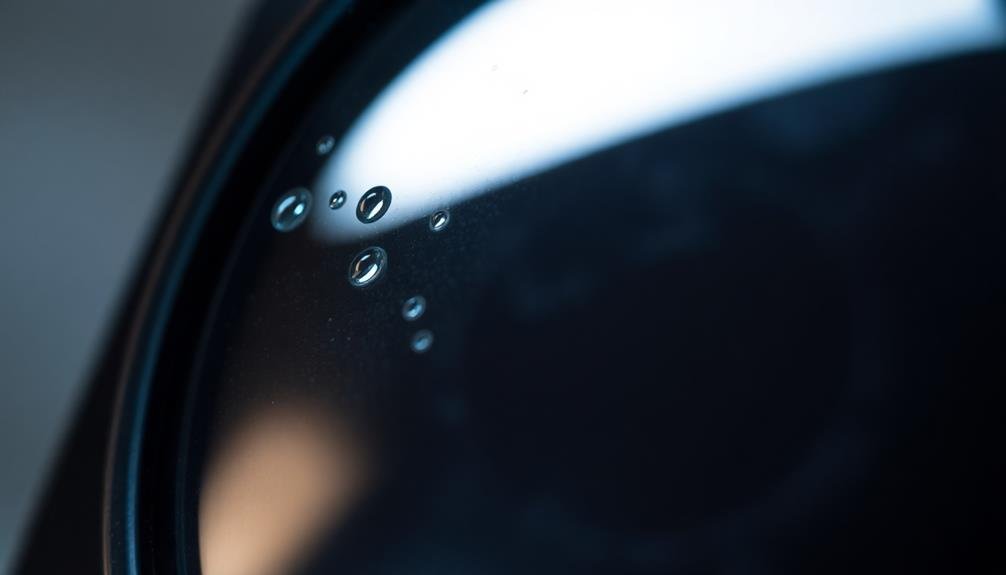
You'll notice a significant boost in image sharpness when using a macro lens for your smartphone.
The enhanced focus precision allows you to capture even the tiniest subjects with crystal-clear clarity, reducing blur effects that often plague close-up shots.
With this improved sharpness, you'll be able to showcase intricate textures and clearer fine details in your macro photographs, elevating the overall quality of your images.
Enhanced Focus Precision
Harnessing advanced optical technologies, smartphone macro lenses greatly enhance focus precision, resulting in improved image sharpness. These specialized lenses allow you to capture intricate details that your phone's built-in camera might miss. By bringing your subject closer and magnifying it, you'll be able to achieve razor-sharp focus on even the tiniest elements.
When using a macro lens, you'll notice a significant increase in your ability to control the focal point. You can now select specific areas of your subject to emphasize, creating a striking contrast between sharp and blurred sections. This precision enables you to highlight textures, patterns, and minute features that would otherwise go unnoticed.
The enhanced focus precision also helps you overcome common macro photography challenges. You'll find it easier to manage the shallow depth of field typical in close-up shots, ensuring that critical parts of your subject remain in focus.
Additionally, the improved optics reduce chromatic aberration and distortion, further contributing to overall image sharpness. By mastering the use of your smartphone's macro lens, you'll elevate your close-up photography skills and capture stunning, professional-quality images with remarkable clarity and detail.
Reduced Blur Effects
Smartphone macro lenses excel at reducing blur effects, greatly improving image sharpness in close-up photography. When you attach a macro lens to your smartphone, you'll notice a significant reduction in motion blur and camera shake. This is because macro lenses often have built-in stabilization features that counteract small movements, allowing you to capture crisp, detailed images even in challenging conditions.
The reduced blur effects also stem from the lens's ability to gather more light and focus it precisely on your smartphone's image sensor. This increased light sensitivity means you can use faster shutter speeds, further minimizing the risk of blur from subject or camera movement.
Additionally, macro lenses often have a wider aperture, which allows for a shallower depth of field. This not only creates a pleasing background blur but also helps isolate your subject, making it appear sharper and more defined.
Clearer Fine Details
The ability to capture clearer fine details is a standout feature of smartphone macro lenses. When you clean your lens regularly, you'll notice a significant improvement in image sharpness. Dust, fingerprints, and smudges can obscure intricate textures and patterns, but a clean lens reveals these minute details with stunning clarity.
You'll be amazed at the difference a clean lens makes when photographing small subjects. Textures become more pronounced, and you'll start to see details you've never noticed before. This enhanced clarity is particularly essential for macro photography, where every tiny element counts.
Here's a comparison of what you might capture with a clean vs. dirty lens:
| Subject | Clean Lens | Dirty Lens |
|---|---|---|
| Flower Petal | Visible pollen grains | Blurry, indistinct surface |
| Insect Wing | Clear vein patterns | Hazy, lack of definition |
| Fabric | Individual fibers visible | Muddled texture |
| Water Droplet | Sharp surface tension | Fuzzy edges |
| Leaf Surface | Distinct stomata | Unclear cellular structure |
Enhanced Color Accuracy

While many smartphone cameras struggle with color accuracy in macro shots, specialized lenses for macro photography often come with features to enhance color fidelity.
These lenses can help you capture the true hues of your subject, whether it's a vibrant flower petal or a subtle insect wing pattern.
When you use a macro lens, you'll notice improved color reproduction. This is because these lenses are designed to minimize chromatic aberration, which can cause color fringing in close-up shots.
They also often have better light transmission properties, allowing more accurate colors to reach your phone's sensor.
You'll find that a clean macro lens considerably impacts color accuracy. Even small smudges or dust particles can alter the way light passes through the lens, potentially skewing colors.
By keeping your lens clean, you're ensuring that nothing interferes with the true colors of your subject.
Additionally, some macro lenses come with coatings that reduce glare and improve contrast. This can help you capture more saturated, true-to-life colors in your macro photographs, especially in challenging lighting conditions.
With a clean, high-quality macro lens, you'll be able to showcase the intricate color details of your tiny subjects with remarkable accuracy.
Reduced Glare and Reflections

Clarity is key when capturing macro shots, and a specialized lens can greatly reduce glare and reflections that often plague close-up photography. When you're shooting small subjects up close, even the slightest glare can ruin your shot.
A clean, high-quality macro lens for your smartphone helps minimize these issues, allowing you to capture crisp, detailed images without distracting reflections.
By reducing glare and reflections, you'll achieve:
- Better contrast: With fewer unwanted light artifacts, your subject's details will stand out more prominently against the background.
- Improved color accuracy: Reduced glare means more accurate representation of your subject's true colors.
- Enhanced texture visibility: Minimized reflections allow you to capture intricate textures and surfaces with greater precision.
You'll notice a significant difference in your macro photography when using a lens designed to combat these issues. It's especially useful when photographing shiny or reflective subjects like insects, jewelry, or water droplets.
Remember to keep your lens clean and free from smudges or fingerprints, as these can introduce unwanted glare. With a specialized macro lens and proper maintenance, you'll be able to capture stunning close-up images with minimal distractions from glare and reflections.
Preventing Lens Scratches
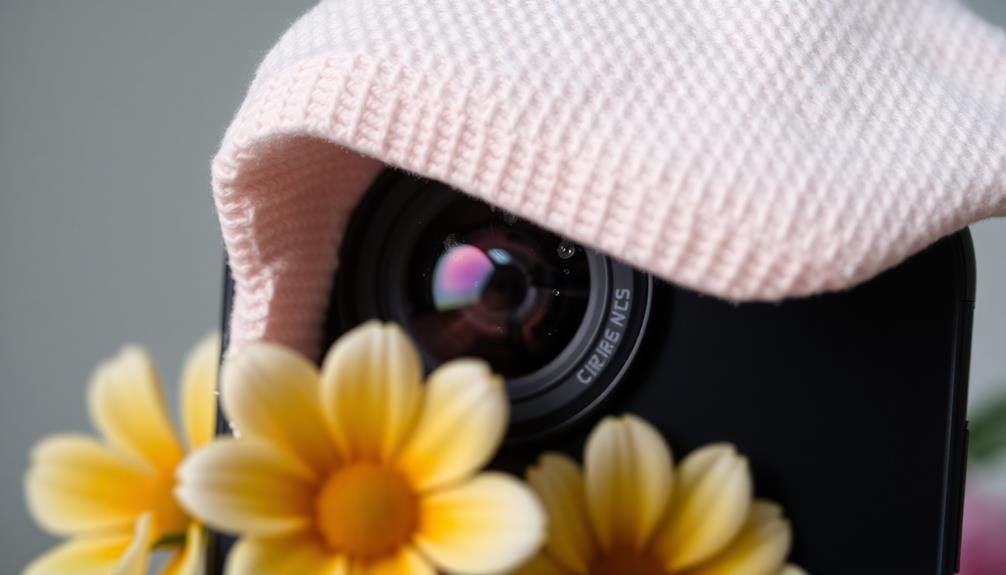
You'll want to protect your smartphone's macro lens from scratches to maintain image quality.
Even tiny dust particles can cause micro-abrasions over time, potentially affecting your close-up shots.
Invest in a lens with high-quality protective coatings, as these can greatly reduce the risk of scratches and extend the life of your macro attachment.
Dust Causes Micro-Abrasions
Photographers know that dust is the silent enemy of camera lenses. When it comes to your smartphone's macro lens, this microscopic menace can cause even more damage.
As you handle your phone throughout the day, dust particles accumulate on the lens surface. These tiny granules act like sandpaper, creating micro-abrasions that gradually degrade image quality.
Every time you wipe your lens with a cloth or your shirt, you're potentially dragging these abrasive particles across the delicate glass. Over time, these micro-scratches add up, leading to noticeable lens degradation.
To protect your macro lens from dust-induced damage:
- Use a soft, lint-free microfiber cloth for cleaning
- Employ a gentle, circular motion when wiping the lens
- Consider using a lens blower to remove dust before wiping
Protective Coatings Matter
Protection is paramount when it comes to preserving your smartphone's macro lens. The protective coating on your lens serves as a vital barrier against scratches, smudges, and other potential damage. This thin layer of material, often made of sapphire crystal or hardened glass, acts as the first line of defense for your delicate lens.
You'll want to guarantee this coating remains intact to maintain peak image quality. Even minor scratches can affect your macro shots, causing unwanted lens flare or reduced sharpness. To protect the coating, always use a lens cap or case when you're not using your phone.
When cleaning, opt for microfiber cloths and avoid abrasive materials that might wear down the protective layer. Some photographers choose to add an extra layer of protection by applying a clear UV filter or lens protector. While this can offer additional safety, be aware that it may slightly impact image quality.
Regularly inspect your lens for any signs of coating wear, and if you notice any damage, consider professional repair to prevent further deterioration. By prioritizing the care of your lens's protective coating, you'll guarantee consistently high-quality macro photographs for years to come.
Maintaining Autofocus Performance

Maintaining autofocus performance is vital when using a smartphone lens for macro photography. A clean lens guarantees your camera can quickly and accurately focus on your subject, capturing sharp, detailed images.
When dust, smudges, or debris accumulate on your lens or attachment, they can interfere with the autofocus system, leading to blurry or improperly focused shots.
To keep your autofocus performing at its best, you'll need to clean your lens regularly. This is especially important for macro photography, where even the slightest focus issue can ruin an otherwise perfect shot.
Here's why maintaining a clean lens is essential for autofocus:
- It prevents focus hunting, where the camera struggles to find the correct focus point.
- It guarantees faster focus acquisition, allowing you to capture fleeting moments in nature.
- It maintains the accuracy of your camera's focus system, particularly in challenging lighting conditions.
When cleaning your lens, use a microfiber cloth or lens cleaning solution designed for camera optics. Avoid using harsh chemicals or abrasive materials that could damage the lens coating.
Maximizing Low Light Capabilities

While a clean lens guarantees sharp focus, it's equally important to master low light photography with your smartphone's macro lens. In dimly lit conditions, you'll need to employ specific techniques to capture clear, detailed images.
First, stabilize your phone using a tripod or by resting it on a stable surface. This prevents camera shake, which is more pronounced in low light.
Next, adjust your camera settings manually if possible. Increase the ISO, but be cautious of introducing excessive noise. Slow down the shutter speed to allow more light in, but remember this may blur moving subjects. Use the exposure compensation feature to fine-tune brightness.
Consider using additional light sources. A small LED light or even your phone's flashlight can make a significant difference. Position the light at various angles to highlight textures and create interesting shadows.
Experiment with HDR mode, which can help balance exposure in tricky lighting situations.
Prolonging Lens Coating Lifespan

To prolong your macro lens coating's lifespan, you'll need to focus on preventing deterioration and maintaining optical clarity.
You can achieve this by handling your lens carefully and avoiding scratches or damage to its delicate surface.
Regular cleaning with appropriate materials and storing your lens properly when not in use will help preserve its coating and guarantee peak performance for your smartphone macro photography.
Prevent Coating Deterioration
Longevity is key when it comes to preserving the coating on your smartphone's macro lens. To prevent coating deterioration, you'll need to adopt a proactive approach to lens care.
Regular cleaning isn't just about maintaining image quality; it's about protecting the delicate coating that enhances your lens's performance.
Harsh chemicals and abrasive materials can quickly degrade the lens coating, so it's essential to use only approved cleaning solutions and microfiber cloths. Always start with a gentle air blower to remove loose particles before wiping the lens.
When cleaning, use light, circular motions from the center outward to avoid scratching the coating.
To further prevent coating deterioration:
- Store your smartphone in a protective case when not in use
- Avoid exposing the lens to extreme temperatures or humidity
- Use lens caps or covers when carrying your device in a bag or pocket
Maintain Optical Clarity
Crystal-clear images start with a well-maintained lens coating. To maintain optical clarity, you'll need to focus on preserving the delicate coating that enhances your smartphone's macro photography capabilities. Regular cleaning and proper care will guarantee your lens continues to perform at its best, capturing the tiniest details with stunning precision.
To maintain optical clarity and prolong your lens coating's lifespan, follow these key practices:
| Cleaning Methods | Maintenance Tips |
|---|---|
| Use microfiber cloth | Store in protective case |
| Apply lens cleaning solution | Avoid extreme temperatures |
| Blow away dust with air blower | Keep away from moisture |
| Gently wipe in circular motion | Replace lens cap when not in use |
Avoid Scratches and Damage
Preserving your smartphone's macro lens coating goes beyond regular cleaning.
You'll want to take extra precautions to avoid scratches and damage that can compromise image quality and shorten the lens's lifespan. Always use a soft, lint-free cloth when wiping the lens, and avoid abrasive materials that could leave micro-scratches on the delicate coating.
When you're not using your macro lens, store it in a protective case or pouch to shield it from dust, debris, and accidental impacts.
Be mindful of where you set your phone down, especially when the lens is attached. Placing it face-down on rough surfaces can lead to scratches or chips in the coating.
To further protect your macro lens and extend its lifespan, follow these key practices:
- Use lens caps or covers when the lens isn't in use
- Clean the lens gently and only when necessary
- Avoid exposing the lens to extreme temperatures or humidity
Consistency in Photo Quality

When you're investing in a smartphone lens for macro photography, you'll want to confirm it delivers consistent results. A clean lens is essential for maintaining this consistency. Dust, fingerprints, or smudges on your lens can greatly impact the quality of your photos, leading to inconsistent results across your macro shots.
By keeping your lens clean, you'll make certain that every photo you take is crisp, clear, and true to the subject. You'll avoid unexpected blurry spots, unwanted glare, or distorted colors that can ruin an otherwise perfect macro image.
Regular cleaning also helps you maintain a professional standard in your work, especially if you're using your macro photography for business or artistic purposes.
Additionally, a clean lens allows you to fully utilize the capabilities of your smartphone's camera and the macro lens attachment. You'll be able to capture the intricate details and textures that make macro photography so enchanting.
Easier Post-Processing
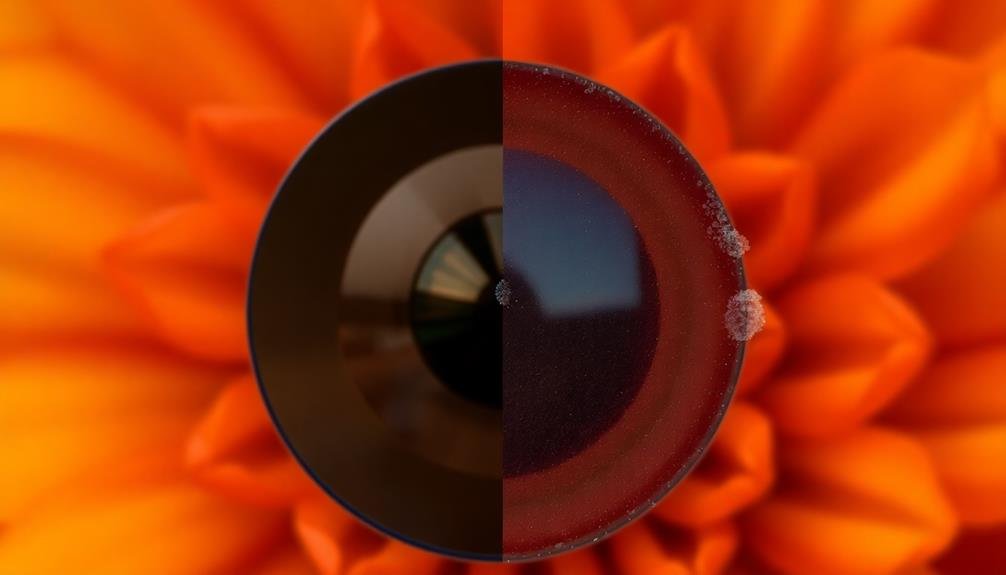
With a high-quality smartphone lens for macro photography, you'll find post-processing becomes considerably easier. A clean, well-maintained lens captures sharper images with better color accuracy and contrast, reducing the need for extensive editing.
You'll spend less time adjusting exposure, sharpness, and color balance, allowing you to focus on creative enhancements instead of corrective measures.
When your lens is clean, you'll notice:
- Reduced noise in low-light situations, minimizing the need for noise reduction tools
- More accurate white balance, saving time on color correction
- Better detail retention, particularly in textures and fine structures
These improvements streamline your workflow, enabling you to achieve your desired results more quickly and efficiently.
You'll have more flexibility to experiment with different editing styles without compromising image quality. Additionally, a clean lens helps maintain consistent results across your photo series, making batch processing more straightforward.
By starting with higher-quality raw images, you'll preserve more data for manipulation, giving you greater control over the final outcome.
Ultimately, a clean smartphone lens for macro photography not only enhances your initial capture but also simplifies and improves your entire post-processing experience.
Professional-Looking Macro Results
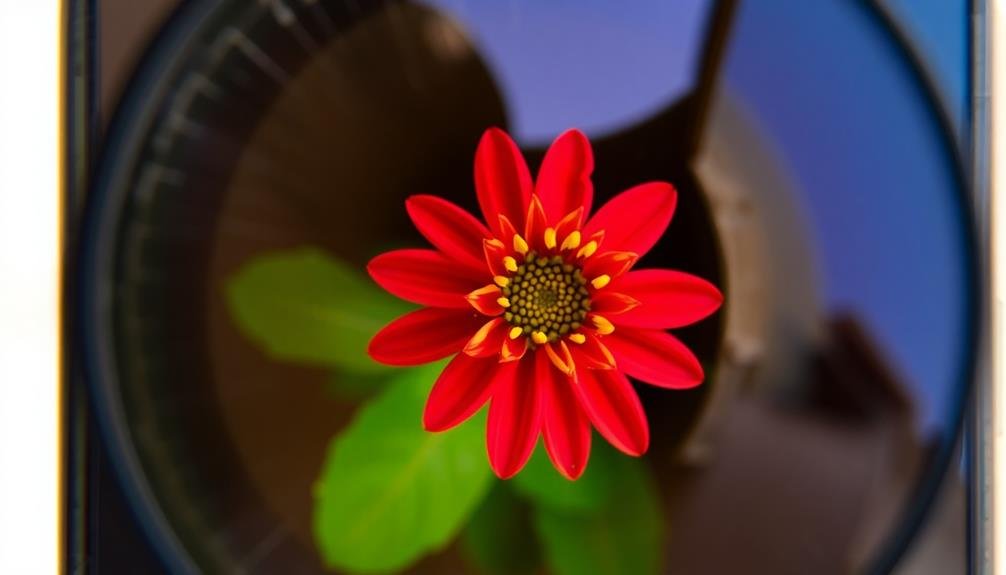
A high-quality smartphone lens for macro photography can elevate your images to a professional level. When you attach a dedicated macro lens to your smartphone, you'll notice a significant improvement in image quality and detail.
These lenses allow you to capture intricate textures, patterns, and tiny subjects with stunning clarity. You'll be able to achieve a shallow depth of field, creating that coveted bokeh effect that separates your subject from the background.
This separation adds dimension and visual interest to your macro shots, making them look more polished and professional. With a proper macro lens, you can get much closer to your subject than with your phone's built-in camera.
This proximity allows you to reveal details invisible to the naked eye, opening up a whole new world of creative possibilities. You'll capture the delicate veins of a leaf, the compound eyes of an insect, or the intricate patterns on a flower petal with remarkable precision.
The increased magnification and improved optical quality will result in sharper images with better color accuracy and contrast. Your macro photos will stand out on social media and may even be suitable for printing or professional use.
Avoiding Unwanted Lens Flare
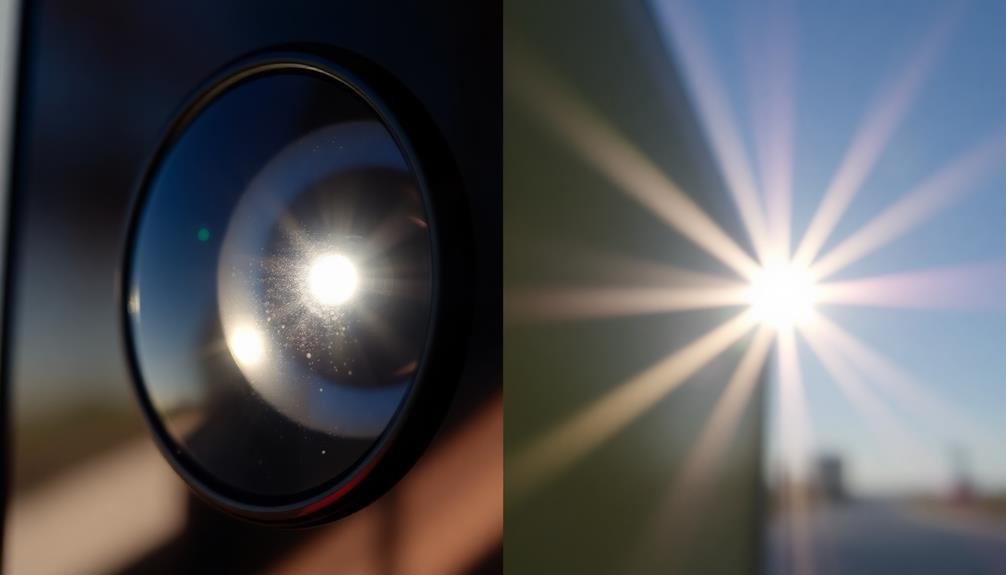
Lens flare can be a beautiful effect in some photos, but for macro photography, it's often an unwanted distraction.
When you're capturing intricate details of small subjects, any unwanted light artifacts can obscure the very features you're trying to highlight. To avoid lens flare in your macro shots, you'll need to be mindful of your light sources and how they interact with your smartphone's lens.
First, try to position yourself so that direct light isn't hitting the lens. This might mean changing your angle or using a physical barrier to block the light.
If you're shooting outdoors, consider using a lens hood or even your hand to shield the lens from sunlight. When indoors, be aware of artificial light sources that could cause flare.
To further reduce the risk of lens flare:
- Clean your lens thoroughly before each shoot
- Use manual focus to prevent autofocus from being thrown off by flare
- Experiment with different angles to find the sweet spot where flare is minimized
Smartphone Resale Value
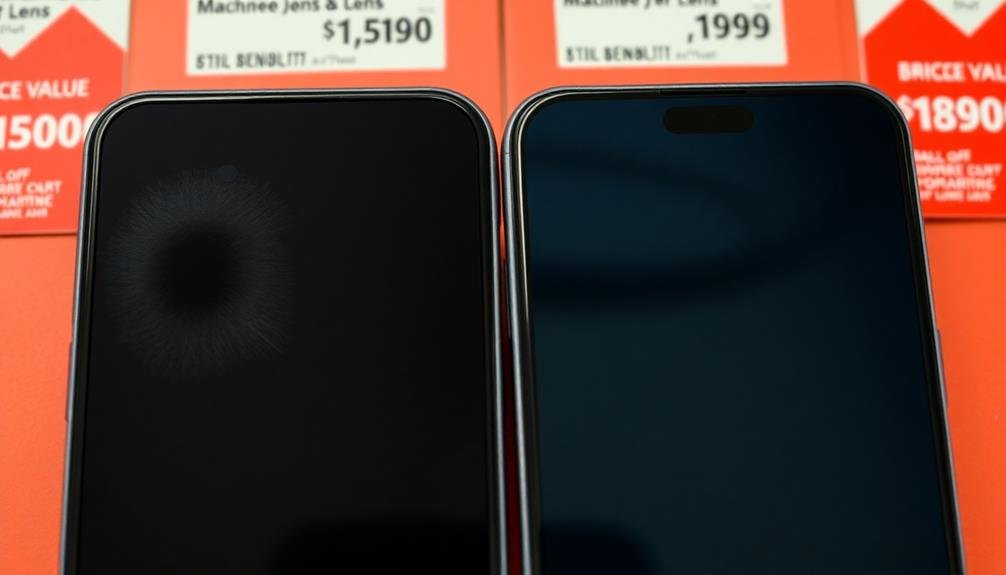
To maintain your smartphone's market price, consider investing in high-quality macro lenses that won't damage your device's camera.
These accessories can enhance your phone's long-term investment potential by expanding its photographic capabilities without compromising its integrity.
Maintain Device's Market Price
Savvy smartphone users know that maintaining their device's market price is vital for maximizing resale value. By keeping your smartphone in top condition, you'll guarantee it fetches the highest possible price when it's time to upgrade. This includes taking care of the camera lens, which is an important component for many buyers.
To maintain your device's market price, focus on these key areas:
- Protect the exterior: Use a high-quality case and screen protector to prevent scratches, dents, and cracks.
- Keep it clean: Regularly wipe down your phone, especially the camera lens, to prevent buildup of dirt and grime.
- Maintain software: Install updates promptly and avoid jailbreaking or rooting your device.
Enhance Long-Term Investment Potential
Enhancing your smartphone's long-term investment potential is vital for maximizing its resale value. When you take proper care of your device's camera lens, you're not just improving your macro photography; you're also preserving its overall condition. A well-maintained lens contributes to better image quality, which is a key selling point for many buyers in the second-hand market.
By regularly cleaning and protecting your smartphone's lens, you're safeguarding its optical performance and preventing scratches or damage that could greatly decrease its value. Potential buyers often scrutinize the camera quality when considering a used smartphone, so a pristine lens can set your device apart from others.
Moreover, demonstrating that you've taken meticulous care of your phone's camera can indicate overall responsible ownership. This perception can lead to higher offers when it's time to sell or trade in your device.
Attract Potential Buyers Quickly
Speed is essential when attracting potential buyers for your used smartphone. A clean lens can greatly impact your device's appeal and help you sell it quickly.
When potential buyers browse listings, they're often drawn to clear, high-quality photos that showcase the phone's features. A spotless lens guarantees your device's images stand out, increasing the likelihood of a fast sale.
To attract buyers quickly and maximize your smartphone's resale value, consider these key points:
- Highlight the pristine condition of your phone's camera by posting crystal-clear sample photos.
- Mention the regular maintenance and care you've given to the lens in your listing description.
- Offer to demonstrate the camera's capabilities in person or through a video call with interested buyers.
Frequently Asked Questions
How Often Should I Clean My Smartphone Lens for Macro Photography?
You should clean your smartphone lens before each macro photography session. It's essential to wipe away any smudges, dust, or fingerprints that can affect image quality. Make it a habit to keep your lens pristine for best results.
What Cleaning Materials Are Safe to Use on Smartphone Camera Lenses?
You can safely clean your smartphone camera lens with microfiber cloths, lens cleaning wipes, or a soft brush. Avoid harsh chemicals or abrasive materials. For stubborn smudges, use a small amount of distilled water or lens cleaning solution.
Can Lens Cleaning Affect the Water-Resistant Properties of My Smartphone?
Yes, aggressive cleaning can potentially affect your smartphone's water resistance. You'll want to be gentle when cleaning lenses. Don't use abrasive materials or excessive liquid, as they might compromise the seals protecting your device from water damage.
Are There Any Risks Associated With Over-Cleaning Smartphone Camera Lenses?
Yes, there are risks with over-cleaning your smartphone's camera lens. You'll potentially damage the lens coating, scratch the glass, or wear down water-resistant seals. It's best to clean only when necessary and use gentle, appropriate methods.
How Can I Tell if My Smartphone Lens Needs Cleaning for Macro Photography?
You'll notice blurry or smudged images when your lens needs cleaning. Hold your phone up to a light source and look for visible dirt or smears. If you see any, it's time to give your lens a gentle wipe.
In Summary
You've now learned why cleaning your smartphone lens is essential for macro photography. By keeping it spotless, you'll capture sharper, more vibrant images with less glare and unwanted effects. It'll make post-processing a breeze and help you achieve professional-looking results. Don't forget, a clean lens also maintains your phone's resale value. So, grab that microfiber cloth and give your lens a quick wipe before your next macro shoot. Your photos will thank you!

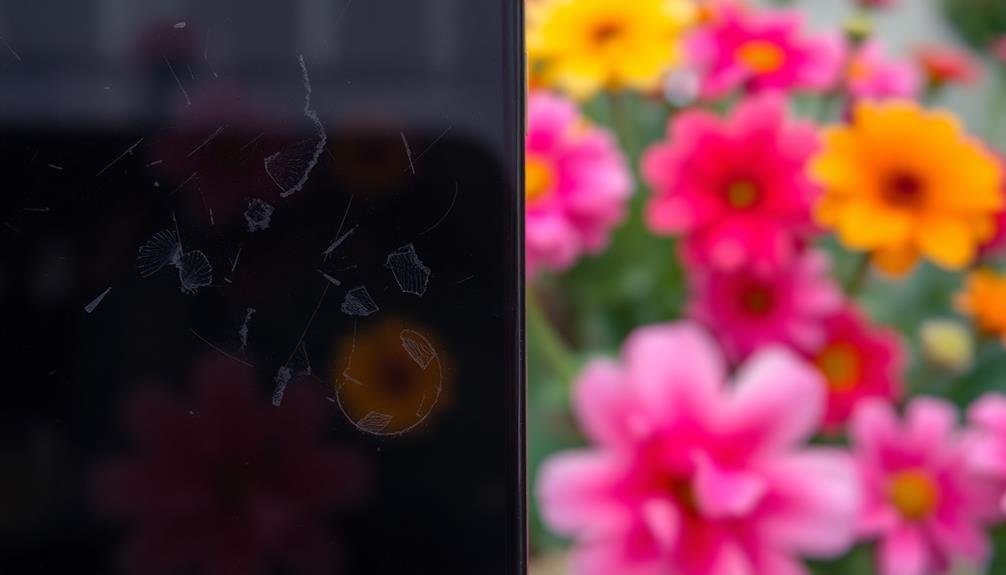

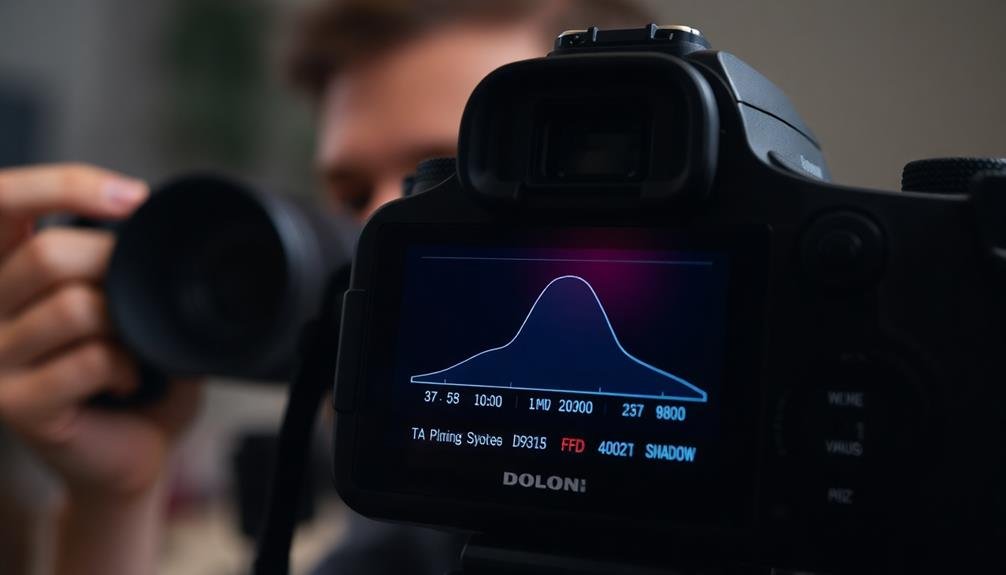
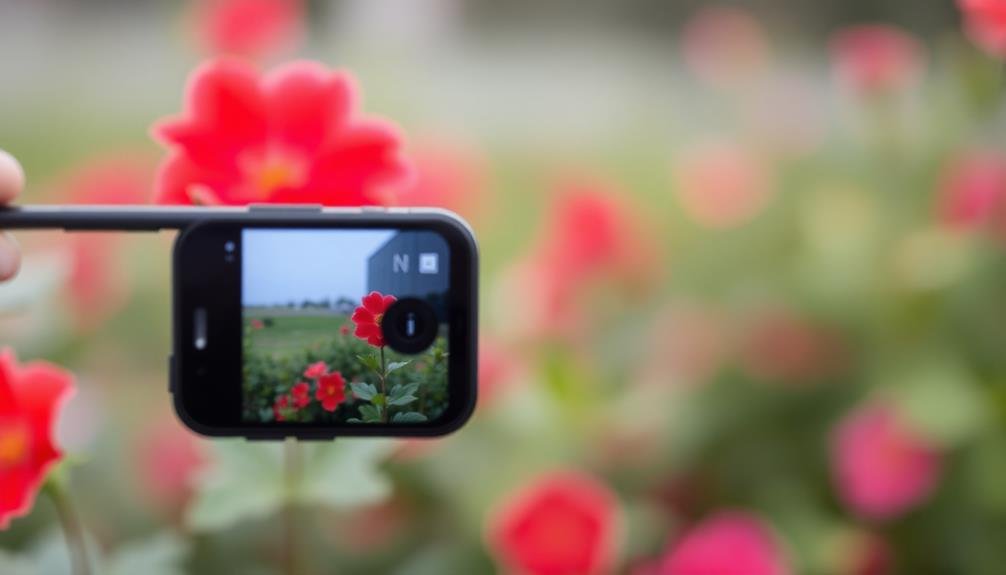
Leave a Reply